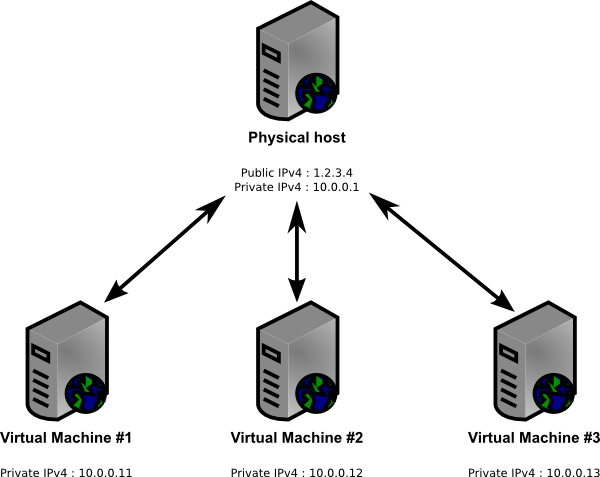Varnish : use multiple backends depending on host / URL
With the lack of public IPv4 address and the growth of virtualization, one of the commons solutions consists in using revese proxies to distribute the traffic of a physical host, having a public IPv4 address, between multiple virtual machines (VM), as shown in the schema below :
In this example, we will assume that each VM hosts a HTTP server (Apache, lighttpd, nginx, etc.) listening on port 80, and that :
- www.myhost1.com should use VM1
- www.myhost2.com should use VM2
- www.myhost3.com should use VM3
Varnish
Varnish, one of the best known reverse proxy engines (actually a caching HTTP reverse proxy), can be very useful in such a situation, by setting specific backends (ie. a VM) depending on the required hostname.

I'm not going to explain in this post how to build the whole Varnish VCL file, but you'll find very useful resources on Varnish's wiki : Varnish Default VCL Example.
Defining multiple backends
First of all, you will need to define the different backends that Varnish will rely on. In the example above, we have 3 VMs with each a private IPv4 in the 10.0.0.0/24 range. At the beggining of your VCL, set your backends :
backend vm1 {
.host = "10.0.0.11";
.port = "80";
.connect_timeout = 6000s;
.first_byte_timeout = 6000s;
.between_bytes_timeout = 6000s;
}
backend vm2 {
.host = "10.0.0.12";
.port = "80";
.connect_timeout = 6000s;
.first_byte_timeout = 6000s;
.between_bytes_timeout = 6000s;
}
backend vm3 {
.host = "10.0.0.13";
.port = "80";
.connect_timeout = 6000s;
.first_byte_timeout = 6000s;
.between_bytes_timeout = 6000s;
}
Using the appropriate backend
To define which backend (local HTTP server) should be used by Varnish to respond HTTP requests, we will set a few custom rules in the vcl_recv section of our VCL config file :
# Default backend is set to VM1
set req.backend = vm1;
if (req.http.host == "www.myhost2.com") {
set req.backend = vm2;
}
if (req.http.host == "www.myhost3.com") {
set req.backend = vm3;
}
Now restart Varnish and try to connect to one of the 3 hostnames : you should be forwarded to the appropriate backend.
NB : this post only covers HTTP reverse proxying, as Varnish does not handle HTTPS. If you need to use HTTPS, there are 2 options : using Apache as HTTPS reverse proxy (in French), or combining Varnish with another server such as Pound, which will handle the SSL communcation establishment.

I'm Michael BOUVY, CTO and co-founder of Click&Mortar, a digital agency based in Paris, France, specialized in e-commerce.
Over the last years, I've worked as an Engineering Manager and CTO for brands like Zadig&Voltaire and Maisons du Monde.
With more than 10 years experience in e-commerce platforms, I'm always looking for new challenges, feel free to get in touch!
